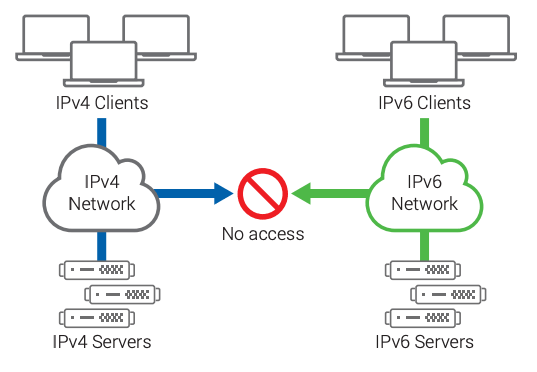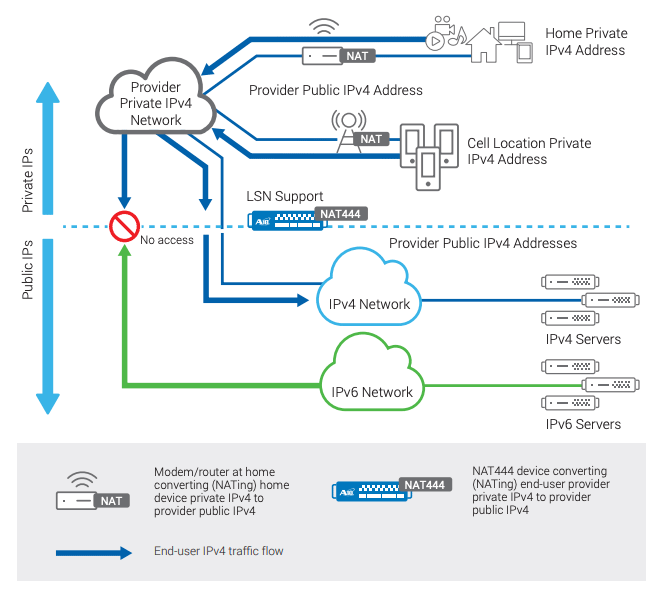What Is IPv6 and What is IPv4 to IPv6 Translation?
What Is IPv6 and Why Do We Need It?
IPv6 is the current standard for assigning public IP addresses to internet-connected devices. A successor to the IPv4 standard, which was introduced in the early 1980s, IPv6 was developed to address the problem of IPv4 exhaustion—the depletion of available IPv4 addresses due to the unanticipated exponential growth in internet connectivity. Offering a pool of unique IP addresses many orders of magnitude larger than IPv4, IPv6 will allow internet connectivity for a virtually unlimited number of devices. In this sense, the question “what is IPv6?” can be answered simply: a perfect solution to the IP address exhaustion problem for the long term.

However, while IPv6 offers many advantages over IPv4, including improved efficiency, security, simplicity, and quality of service (QoS) in addition to ample supply, the issue of IPv6 vs IPv4 isn’t as straightforward as replacing an outdated standard with an improved version. To begin with, IPv6 is not backward compatible with IPv4, leading to numerous challenges with coexistence and migration between the two standards. Indeed, more than two decades after the introduction of IPv6, organizations continue to grapple with the nuances of IPv6 vs IPv4, and will likely continue to do so for years to come. For technology organizations tasked with reconciling IPv6 vs IPv4 incompatibility, the response to “what is IPv6?” might not be as enthusiastic.
Learn more about IPv4 to IPv6 migration
IPv6 vs IPv4
In technical terms, IPv6 is clearly superior to IPv4. Using an 128-bit address, rather than the 32-bit addresses used by IPv4, IPv6 will easily accommodate vast numbers of internet users, always-on devices, mobile devices, IoT, and anything else people may want to connect via IP. But the transition to IPv6 has proven to be far too complex to achieve overnight. Because direct communication between IPv4 and IPv6 is not possible, all three elements of the connectivity ecosystem must be aligned on the same standard: content, devices, and networks. It’s not enough for operators to convert their own infrastructure to IPv6 (an ongoing work in progress), or for devices to support the standard (many do, but far from all)—the web destinations providing content must also use IPv6. To date, the majority of websites and web traffic worldwide remain IPv4-only.

No built-in communication or backward compatibility between IPv4 and IPv6 networks
As the IPv6 vs IPv4 conflict slogs on, service providers and enterprises face the need to support both standards to ensure that users can access the full range of internet content on any device they use. Meanwhile, full IPv6 migration for a data center and network represents a costly, time-consuming, and disruptive process encompassing every connected device and application in the environment. In some cases, the entire network must be re-architected. And all this work competes for budget and resources with more strategic technology initiatives such as software-defined networking, cloud, 5G, and edge. In this light, organizations have an urgent need for simple, cost-effective ways to bridge the IPv6 vs IPv4 gap such as IPv4 to IPv6 translation.
IPv4 to IPv6 translation
While full IPv6 migration remains the ultimate goal, IPv4 and IPv6 infrastructure will continue to coexist at each level of the connectivity chain—content, devices, and networks—for years to come. In fact, by facilitating this coexistence, organizations can buy time to make a less rushed, more orderly, and efficient transition. To this end, several technologies have been developed to enable connectivity between IPv4 and IPv6 devices, networks, and websites through IPv4 to IPv6 translation.
Network address translation (NAT) techniques for IPv4 to IPv6 translation, such as NAT64 or NAT46, work with DNS64 to translate between the IPv4 and IPv6 protocol stacks at a gateway within the provider’s network to ensure connectivity regardless of which standard is natively supported by either the subscriber or the provider network. In the case of an IPv6 end-user, DNS requests are received and resolved by the DNS64 device. If there is an IPv6 DNS record, the resolution is forwarded to the end-user and they can access the resource directly over the service provider’s IPv6 infrastructure. If only an IPv4 address is available, DNS64 converts the record using its NAT64 prefix and forwards it to the end user. The end user then accesses the NAT64 device, which translates the traffic to the IPv4 server.

Service provider NAT444 solution
While NAT64/DNS64 offers IPv6 clients access to IPv4 content with no disruption to IPv4 infrastructure, it can’t help IPv4 clients access IPv6 content. In addition, some popular IPv4-only applications, such as Skype and WhatsApp, can’t function through NAT64. In these cases, organizations can turn to 464XLAT, a technique in which the client uses a SIIT translator (Stateless IP/ICMP Translation) to convert IPv4 packets into IPv6 to send over an IPv6-only network to a NAT64 translator. After translation into IPv4, the packets can then be sent over an IPv4-capable network to the IPv4-only server for Skype, WhatsApp, or any other IPv4-only application. Note that while 464XLAT eliminates the need to maintain an IPv4 network to assign additional public IPv4 addresses to support this traffic, it does have limitations; it only supports IPv4 in the client-server model and does not support IPv4 peer-to-peer communication or inbound IPv4 connections.
Mapping of address and port using translation (MAP-T) offers another option for IPv4 to IPv6 translation. Using stateless NAT64 techniques and MAP rules, MAP-T translates IPv4 packets to IPv6 so that they can be carried on an IPv6-only access network.
Proven CGNAT Solutions
A10 Networks’ IPv4 preservation with carrier-grade NAT (CGNAT) and IPv6 migration technologies are proven solutions to meet your increased subscriber and IoT network expansion demands and ensure connectivity.
How A10 Networks Helps Customers Migrate from IPv6 to IPv4
A10 Networks helps organizations bridge the gap between IPv4 and IPv6 with solutions for IPv4 preservation and IPv6 migration. A10 Networks Thunder® CGN, the most advanced carrier-grade networking solution, provides high-performance CGNAT with protocol translation that allows service providers and enterprise to extend IPv4 investment while simultaneously transitioning to IPv6 standards. A10 Networks Thunder CFW incorporates address translations between IPv4 and IPv6 into a high-performance, all-inclusive security product. To learn more—and take the angst out of the question, “what is IPv6?”—explore our resources on IPv4 Preservation and IPv4 to IPv6 Migration.
Public Telecomm Solves IPv4 Exhaustion & Saves ~$2 Million
Related Resources
- How to Co-exist with IPv4 and IPv6 using CGNAT (eBook)
- DDoS Protection for CGNAT Environments (Solution Brief)
- CGNAT Isn’t a Capability, It’s a Lifecycle Strategy (White Paper)
- The End of IPv4? Migration Paths to IPv6 (White Paper)
